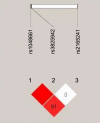Evaluation of LOXL1 polymorphisms in exfoliation syndrome in a Chinese population
- PMID: 19936304
- PMCID: PMC2779059
Evaluation of LOXL1 polymorphisms in exfoliation syndrome in a Chinese population
Abstract
Purpose: To evaluate the association profiles of the lysyl oxidase-like 1 (LOXL1) gene polymorphisms with exfoliation syndrome in a Chinese population.
Methods: Fifty unrelated patients with exfoliation syndrome and 125 control subjects were included. Genotypes of the three single nucleotide polymorphisms (SNPs) of LOXL1 (rs1048661, rs3825942, and rs2165241) were analyzed by direct sequencing, and a case-control association study was performed.
Results: The three SNPs were significantly associated with exfoliation syndrome (XFS) and exfoliation glaucoma (XFG) individually. After controlling for rs3825942 and rs2165241, the association between rs1048661 and XFS/XFG remained significant (p=3.6 x 10(-7)). At this SNP, the T allele and TT genotype conferred a 7.59-(95% confidence interval [CI]: 3.87-14.89, p=6.95 x 10(-11)) and 8.69-(95% CI: 4.15-18.20, p<1.00 x 10(-7)) fold increased risk to the disease. The alleles of T at rs1048661 and C at rs2165241 were found to be risk alleles in Chinese subjects, which were opposite to Caucasian individuals. The haplotypes T-G, defined by SNPs rs1048661 and rs3825942, and T-C by SNPs rs1048661 and rs2165241, were also significantly associated with the disorder. However when the genotypic or allelic frequencies of the three SNPs were compared between XFS and XFG, no significant difference was detected.
Conclusions: LOXL1 is a susceptibility gene of XFS/XFG in the Chinese population, and the association is mainly attributed to SNP rs1048661. The risk alleles of rs1048661 and rs2165241 in Chinese subjects were found to be opposite to that of Caucasians. The genotypic and allelic distributions of these SNPs are similar between XFS and XFG.
Figures

Similar articles
-
Evaluation of LOXL1 polymorphisms in exfoliation syndrome in the Uygur population.Mol Vis. 2011;17:1734-44. Epub 2011 Jun 28. Mol Vis. 2011. PMID: 21738402 Free PMC article.
-
Evaluation of LOXL1 gene polymorphisms in exfoliation syndrome and exfoliation glaucoma.Mol Vis. 2008 Mar 17;14:533-41. Mol Vis. 2008. PMID: 18385788 Free PMC article.
-
Association of LOXL1 gene polymorphisms with pseudoexfoliation in the Japanese.Invest Ophthalmol Vis Sci. 2008 Sep;49(9):3976-80. doi: 10.1167/iovs.08-1805. Epub 2008 Apr 30. Invest Ophthalmol Vis Sci. 2008. PMID: 18450598
-
From epidemiology to lysyl oxidase like one (LOXL1) polymorphisms discovery: phenotyping and genotyping exfoliation syndrome and exfoliation glaucoma in Iceland.Acta Ophthalmol. 2009 Aug;87(5):478-87. doi: 10.1111/j.1755-3768.2009.01635.x. Acta Ophthalmol. 2009. PMID: 19664108 Review.
-
The role of lysyl oxidase-like 1 (LOXL1) in exfoliation syndrome and glaucoma.Exp Eye Res. 2019 Dec;189:107818. doi: 10.1016/j.exer.2019.107818. Epub 2019 Sep 26. Exp Eye Res. 2019. PMID: 31563608 Review.
Cited by
-
Evaluation of lysyl oxidase-like 1 gene polymorphisms in pseudoexfoliation syndrome in a Korean population.Mol Vis. 2013;19:448-53. Epub 2013 Feb 22. Mol Vis. 2013. PMID: 23441117 Free PMC article.
-
A common variant mapping to CACNA1A is associated with susceptibility to exfoliation syndrome.Nat Genet. 2015 Apr;47(4):387-92. doi: 10.1038/ng.3226. Epub 2015 Feb 23. Nat Genet. 2015. PMID: 25706626 Free PMC article.
-
Genome-wide association studies: applications and insights gained in Ophthalmology.Eye (Lond). 2014 Sep;28(9):1066-79. doi: 10.1038/eye.2014.145. Epub 2014 Jun 27. Eye (Lond). 2014. PMID: 24971990 Free PMC article. Review.
-
Association of lysyl oxidase-like 1 gene common sequence variants in Greek patients with pseudoexfoliation syndrome and pseudoexfoliation glaucoma.Mol Vis. 2013 Jul 12;19:1446-52. Print 2013. Mol Vis. 2013. PMID: 23869164 Free PMC article.
-
Ethnicity-based subgroup meta-analysis of the association of LOXL1 polymorphisms with glaucoma.Mol Vis. 2010 Feb 6;16:167-77. Mol Vis. 2010. PMID: 20142848 Free PMC article.
References
-
- Ritch R, Schlotzer-Schrehardt U, Konstas AG. Why is glaucoma associated with exfoliation syndrome? Prog Retin Eye Res. 2003;22:253–75. - PubMed
-
- Naumann GO, Schlotzer-Schrehardt U, Kuchle M. Pseudoexfoliation syndrome for the comprehensive ophthalmologist. Intraocular and systemic manifestations. Ophthalmology. 1998;105:951–68. - PubMed
-
- Vesti E, Kivel AT. Exfoliation syndrome and exfoliation glaucoma. Prog Retin Eye Res. 2000;19:345–68. - PubMed
-
- Ritch R, Schlotzer-Schrehardt U. Exfoliation syndrome. Surv Ophthalmol. 2001;45:265–315. - PubMed
-
- Hirvela H, Luukinen H, Laatikainen L. Prevalence and risk factors of lens opacities in the elderly in Finland. A population-based study. Ophthalmology. 1995;102:108–17. - PubMed
MeSH terms
Substances
LinkOut - more resources
Full Text Sources
Other Literature Sources
Miscellaneous
